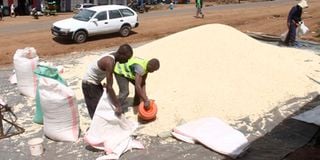Breaking News: At least 10 feared to have drowned in Makueni river
Study: Ugali consumers exposed to health risks due to high aflatoxin levels

Workers dry maize by the roadside in Elburgon, Nakuru County, in January 2022.
Fifteen per cent of maize millers in the country produce flour containing high level of aflatoxin, exposing consumers to health complications, a new market surveillance study has shown.
The study conducted by the Ministry of Health, in partnership with the Jomo Kenyatta University of Agriculture and Technology (JKUAT), found that only 85.3 per cent of millers meet the Kenya Bureau Standards’ (Kebs’) maximum permissible aflatoxin levels.
According to Daniel Sila, a JKUAT professor who coordinated the market surveillance, a disparity in compliance with industry standards on aflatoxin levels was also observed.
“We see a regional disparity in compliance with Kebs standards. Some areas such as Eastern Kenya have a high non-compliance level as compared to others such as the Rift Valley. The findings have been almost constant for the past three years, exposing many Kenyans to danger,” Prof Sila said.
United Grain Millers Association (UGMA) chairperson Ken Nyaga raised concerns about increased non-compliance and urged the government to crack the whip on unscrupulous maize suppliers.
“We have had cases where one miller rejects maize because of high aflatoxin levels, but the maize still finds itself even in some of our boarding schools. It is a sad situation that we are exposing Kenyans to and I urge the government to take action,” Mr Nyaga said.
The findings further indicate most maize and wheat millers do not add essential minerals and vitamins to their flour products. The process, technically known as fortification, is demanded by the government to deal with malnutrition. Maize flour should, for instance, be fortified with zinc and iron minerals, as well as salt with iodine and other vegetable fats and oils with Vitamin A.
Of the total number of those surveyed, only 46.4 per cent of maize millers and 84 per cent of wheat millers complied with fortification standards.
Most of the large-scale maize millers (57.9 per cent) comply, while for small-scale millers, only 30.4 per cent comply.
In Kenya, it is estimated that 70 per cent of the packaged maize flour consumed in the urban areas is produced by large-scale millers. In most of the rural areas and slums, the flour is sourced from small- and medium-scale millers.
The findings indicate most Kenyans would be consuming food without necessary nutrients, exposing themselves to nutrition deficiency, especially vulnerable groups such as women and children.
The researchers visited 104 maize millers across the country and collected 500 samples that were analysed at National Public Health and JKUAT laboratories.





